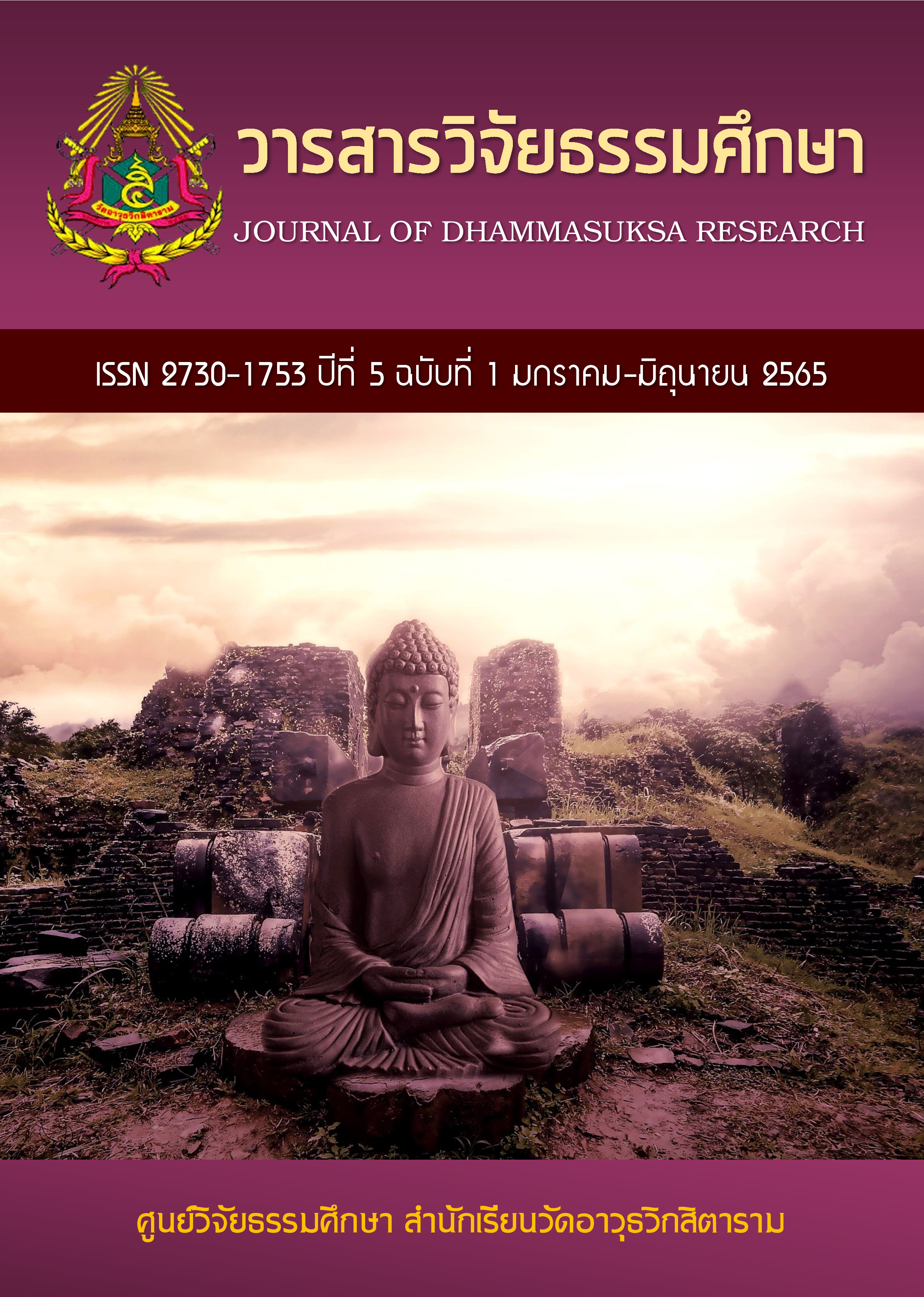The Application Model of Buddhist Hermeneutics on the Laws of Karma for the Youth Problem-Solving in the Postmodern Society
Keywords:
The Application Model, Buddhist Hermeneutics, The Laws of KarmaAbstract
The purpose of research on “The applied model of the Buddhist Hermeneutics on the law of karma to solving youth problems in the new society”, 1) to study the youth problems in the new society, to study the Buddhist Hermeneutics on the law of karma, 3) to apply the model of the Buddhist Hermeneutics on the law of karma to solving youth problems in the new society, and 4) to create the new knowledge and the applied model of the Buddhist Hermeneutics on the law of karma to solving youth problems in the new society. This is qualitative research with documented research methods and field studies under the process of analytical, critical and scientific studies to create of new philosophical and religious knowledge. The results showed that: Youth and teenager are people under the age of 25 years. The nature of human problems according to the philosophical paradigm, everyone has problems, from small to growing up. According to the philosophical paradigm, to analyze in the 3 eras of society. On the primeval era, everything is born from the will of the mystical power without the fixed rules for living in a large society. The ancient paradigm era (450–300 BC), was divided into three sub-eras; “era of Beginning ancient, era of prosperous ancient, and era of decadence ancient" There are five eras of Philosophical Paradigm: Philosophical Paradigm of the primeval era believes that Human Beings in the primeval era happened in the world until 2 - 3 million years ago and lived in nature. Philosophical Paradigm of the ancient era believes the world has rules for solving problems or eliminating suffering. The philosophical Paradigm of the medieval era believes that the world has rules but abided happiness in the next world, dis not focus this world. Problems and causes of the youth problems in the new society are the lack of training, inculcating habits or ethics and mental problems. On objective 2, concept of the Buddhist Hermeneutics of Postmodern Philosophical Paradigms is subject of practicing of interpretation rather than subject of philosophy. On objective 3, there are four main stages of creating the new knowledge and the applied model: exploration, experimentation, learning from practice. Practice for learning. On objective 4, method of using application, adherence to the law of karma, pointing out the importance of the law of karma and body of the new knowledge is the integration of the principle of Threefold Training, the Five Aggregates and the Three Characteristics appended to the Buddhist Hermeneutics on the laws of karma to explain the occurrence of karma and the closeness of karma to human’s life from birth to death.
References
กรมการศาสนา กระทรวงศึกษาธิการ. (2525). พระไตรปิฎกภาษาไทย ฉบับหลวง. กรุงเทพฯ: โรงพิมพ์กรมการศาสนา กระทวรงศึกษาธิการ.
กรมพินิจและคุ้มครองเด็กและเยาวชน. (2554). ระเบียบกรมพินิจและคุ้มครองเด็กและเยาวชนว่าด้วยหลักสูตร การฝึกอบรมเด็กและเยาวชน พุทธศักราช 2554. กรุงเทพฯ: กรมพินิจและคุ้มครองเด็กและเยาวชน.
จักรพันธ์ สุทธิธรรม. (2561). ศึกษาการรับผลกรรมในพุทธปรัชญาเถรวาทที่มีอิทธิพลต่อการดำเนินชีวิต. วารสารพุทธมัคค์ ศูนย์วิจัยธรรมศึกษา สำนักเรียนวัดอาวุธวิกสิตาราม. ปีที่ 3 ฉบับที่ 1 มกราคม-มิถุนายน, 2561: 19-25.
ชัชฎาภรณ์ อยู่เย็นเป็นสุข. (2561). การศึกษาพุทธปรัชญาเพื่อการพัฒนาที่ยั่งยืน. วิทยานิพนธ์ศิลปศาสตรมหาบัณฑิต (การเมืองและยุทธศาสตร์การพัฒนา). คณะพัฒนาสังคมและสิ่งแวดล้อม: สถาบันบัณฑิตพัฒนบริหารศาสตร์.
เบญจวรรณ ชยางกูร ณ อยุธย. (2559). แนวทางการอธิบายเรื่องนรกและสวรรค์ในพุทธศาสนาสำหรับคนรุ่นใหม่. วารสารพุทธมัคค์ ศูนย์วิจัยธรรมศึกษา สำนักเรียนวัดอาวุธวิกสิตาราม. ปีที่ 1 ฉบับที่ 1 มกราคม-มิถุนายน, 2559: 44-53.
พระธรรมปิฎก (ป.อ. ปยุตฺโต). (2546). พจนานุกรมพุทธศาสน์ ฉบับประมวลศัพท์. พิมพ์ครั้งที่ 11. กรุงเทพฯ: มหาจุฬาลงกรณราชวิทยาลัย.
พระพรหมคุณาภรณ์ (ป.อ.ปยุตฺโต). (2551). พจนานุกรมพุทธศาสตร์ ฉบับประมวลธรรม. พิมพ์ครั้งที่ 17. กรุงเทพฯ: มหาจุฬาลงกรณราชวิทยาลัย.
พระพรหมคุณาภรณ์ (ป.อ.ปยุตฺโต). (2559). พุทธธรรม ฉบับปรับขยาย. พิมพ์ครั้งที่ 46. กรุงเทพฯ: โรงพิมพ์ บริษัท สหธรรมิก จำกัด.
มหาจุฬาลงกรณราชวิทยาลัย. (2539). พระไตรปิฎกภาษาไทย ฉบับมหาจุฬาลงกรณราชวิทยาลัย. กรุงเทพฯ: มหาจุฬาลงกรณราชวิทยาลัย.
มหามกุฏราชวิทยาลัย. (2539). อภิธัมมัตถสังคหบาลีและอภิธัมมัตถวิภาวินีฎีกา ฉบับแปลเป็นไทย. กรุงเทพฯ: โรงพิมพ์มหามกุฏราชวิทยาลัย.
มหามกุฏราชวิทยาลัย. (2548). พระไตรปิฎกอรรถกถาภาษาไทย. นครปฐม: โรงพิมพ์มหามกุฏราชวิทยาลัย ในพระบรมราชูปถัมภ์.
วีรณัฐ โรจนประภา, สมบูรณ์ บุญโท และสวัสดิ์ อโณทัย. (2562). การนำกระบวนทรรศน์ปรัชญาหลังนวยุค และพุทธปรัชญามาสร้างสังคมแห่งสัมมาปัญญาในประเทศไทย 4.0. วารสารเซนต์จอห์น. ปีที่ 22 ฉบับที่ 30 มกรคม- มิถุนายน, 2562: 1-37.
วีรชาติ นิ่มอนงค์. (2552). การศึกษาวิเคราะห์ทฤษฎีอรรถปริวรรตศาสตร์ในคัมภีร์พุทธปรัชญาเถรวาทเถรวาท. รายงานการวิจัยฉบับสมบูรณ์. กรุงเทพมหานคร: มหาวิทยาลัยอัสสัมชัญ.
วีรชาติ นิ่มอนงค์. (2558). เฮอร์เมนูติกส์: ศาสตร์แห่งความเข้าใจ (ตีความ) ของพระพุทธปรัชญา (ศาสนา) เถรวาทและมหายานเชิงเปรียบเทียบ. วารสารสารนิพนธ์พุทธศาสตรบัณฑิต, 2558. บัณฑิตวิทยาลัย: มหาวิทยาลัยมหาจุฬาลงกรณราชวิทยาลัย.
วีรชาติ นิ่มอนงค์. (2560). เฮอร์เมนูติกส์: ศาสตร์แห่งความเข้าใจ (ตีความ) ของพระพุทธปรัชญา (ศาสนา) เถรวาทและมหายานเชิงเปรียบเทียบ. วารสารมหาจุฬาวิชาการ. ปีที่ 2 ฉบับที่ 1, 2560: 79-92.
สุรวัฒน์ หิรัณย์สิริกุล. (2563). แนวทางการนำเสนอเรื่องกรรมที่สอดคล้องกับสังคมไทยปัจจุบัน. วารสารสังคมศาสตร์และมานุษยวิทยาเชิงพุทธ. ปีที่ 5 ฉบับที่ 2 กุมภาพันธ์, 2563: 138-154.
อุทัย สติมั่น. (2561). จักกวัตติสูตร: ศึกษาวิเคราะห์บนฐานทฤษฎีอรรถปริวรรตศาสตร์. ธรรมธารา วารสารวิชาการทางพุทธปรัชญาเถรวาท. ปีที่ 4 ฉบับที่ 1 (ฉบับรวมเล่มที่ 6), 2561: 30-66.

Downloads
Published
How to Cite
Issue
Section
License

This work is licensed under a Creative Commons Attribution-NonCommercial-NoDerivatives 4.0 International License.

